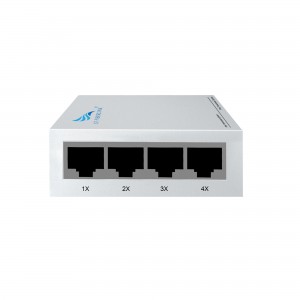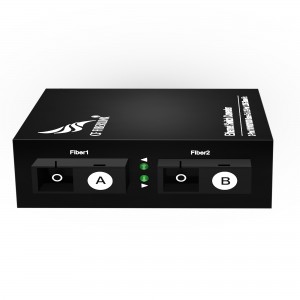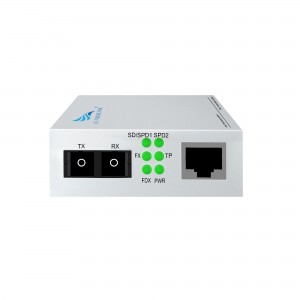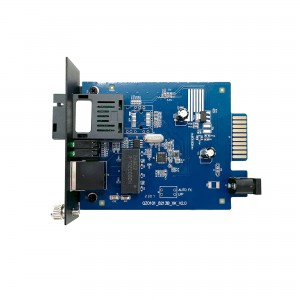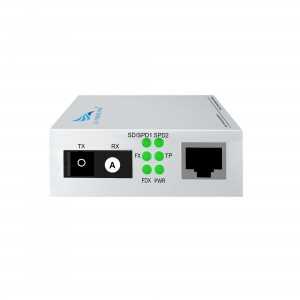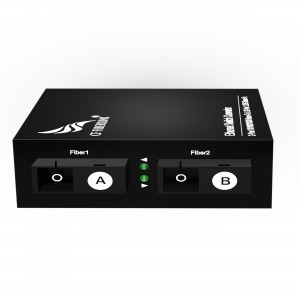10-port 10/100/1000M WDM Media Converter (Single-mode Single-fiber SC)
10-port 10/100/1000M WDM Media Converter (Single-mode Single-fiber SC)
Product Features:
Proud to launch Gigabit 2-fiber 8-power single-mode single-fiber 20km converter – your seamless fiber optic connection solution
Looking for a reliable and high-performance fiber optic converter? Look no further! Huizhou Changfei Optoelectronics Technology Co., Ltd., a leading communication equipment manufacturer, has launched a gigabit 2-fiber 8-power single-mode single-fiber 20km converter, which is the perfect solution to facilitate seamless communication in industrial environments.
Founded in 2009 and headquartered in Huizhou, China, our company has become a trusted supplier of cutting-edge communication equipment. With a state-of-the-art production facility covering an area of over 20,000 square meters and a dedicated team of over 30 R&D professionals, we pride ourselves on being able to provide innovative, reliable solutions to our customers’ needs.
As technology continues to evolve, businesses are challenged to transfer data quickly and securely. Our Gigabit 2 Optical to 8 Electrical Converters provide a versatile solution for converting optical fiber to RJ45, making them ideal for a variety of applications including industrial environments. The converter supports 10/100 Mbps fiber optic conversion, ensuring lightning-fast data transfer without compromising quality.
Our converters are equipped with SC interfaces, which can realize seamless connection and reliable transmission of data between different network nodes. Plus, dynamic LED indicators provide instant visual feedback, ensuring ease of use and troubleshooting.
User-friendly design ensures hassle-free installation. Just plug and play and let our converter do the rest. Enjoy the benefits of fiber optic connectivity without complex setup and configuration. Designed with industrial-grade reliability in mind, our converters can withstand harsh environments, making them suitable for use in manufacturing facilities, industrial automation systems, and other demanding environments.
As a forward-thinking and client-focused organization, we understand the importance of maintaining evolving industry standards. Our Gigabit 2 to 8 electrical converters are designed to meet the requirements of modern communication networks, including the latest advances in fiber optic technology. Experience faster, more stable, and more secure data transfers, ensuring unrivaled reliability and efficiency.
Huizhou Changfei Photoelectric Technology Co., Ltd. regards customer satisfaction and success as the most important thing. With our wide range of products, including 5G communication equipment, 10G core switches, industrial cloud network managed switches, fiber optic transceivers, smart PoE switches, network switches, wireless bridges and optical modules, we have become an innovative and reputable high-tech enterprise . Technology enterprises.
Choose Gigabit 2 Optical 8 Electrical Single Mode Single Fiber 20km Converter and upgrade your communication infrastructure. Experience the superior performance of our reliable, high-performance converters, backed by our commitment to delivering innovative solutions that exceed expectations. Please believe that Huizhou Changfei Photoelectric Technology Co., Ltd. can meet all your communication equipment needs.
A move towards enhanced connectivity and seamless communication. Harness the power of fiber optics with our Gigabit 2 to 8 converters. Unlock the true potential of your industrial network and witness unrivaled speed, reliability and convenience. Invest in the future of communications technology with us.
Technical Parameter:
|
Model |
CF-2018GSW-20 | |
| Interface Characteristics | ||
|
Fixed Port |
8* 10/ 100/ 1000Base-T RJ45 port 2* 1000Base-X uplink SC fiber port |
|
|
Ethernet Port |
10/ 100/ 1000Base-T auto-sensing, full/half duplex MDI/MDI-X self-adaption |
|
|
Twisted Pair Transmission |
10BASE-T: Cat3,4,5 UTP(≤100 meter) 100BASE-T: Cat5e or later UTP(≤100 meter) 1000BASE-T : Cat5e or later UTP(≤100 meter) |
|
| Optical Port | Default optical module is single-mode single-fiber 20km, SC port | |
| Wavelength/Distance | A-end: RX1310nm / RX1550nm 0 ~ 40KM
B-end:RX1550nm/ RX1310nm 0 ~ 40KM |
|
| A-end: RX1490nm / RX1550nm 0 ~ 120KM
B-end:RX1550nm/ RX1490nm 0 ~ 120KM |
||
| Chip Parameter | ||
| Network Protocol | IEEE802.3 10BASE-T, IEEE802.3i 10Base-T,
IEEE802.3u 100Base-TX, IEEE802.3u 100Base-FX, IEEE802.3x IEEE802.3ab 1000Base-T;IEEE802.3z 1000Base-X; |
|
|
Forwarding Mode |
Store and Forward(Full Wire Speed) |
|
|
Switching Capacity |
20Gbps |
|
|
Buffer Memory |
14.88Mpps | |
|
MAC |
2K | |
|
LED Indicator |
Fiber | FX1 (green)-FX2 (green) |
| Data | 1-8 Green: Indicates network working status | |
| Power | PWR (green) | |
| Power | ||
| Working Voltage |
AC:100-240V |
|
|
Power Consumption |
Standby<1W, Full load<5W |
|
|
Power Supply |
DC:5V/2A industrial power supply |
|
| Lightning protection &Certification | ||
| Lightning protection | Lightning protection: 4KV 8/20us, Protection level: IP30 | |
| Certification | CCC;CE mark, commercial; CE/LVD EN60950;FCC Part 15 Class B; RoHS | |
| Physical Parameter | ||
| Operation TEMP | -20~+55°C;5%~90% RH Non condensing | |
| Storage TEMP |
-40~+85°C;5%~95% RH Non condensing |
|
| Dimension (L*W*H) | 198mm* 92mm*28mm | |
| Installation | Desktop | |
Product Size:
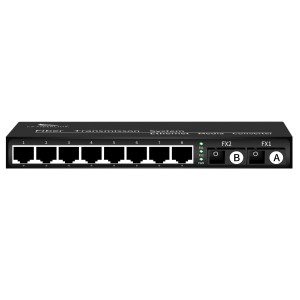
product application diagra:

How to choose a fiber optic transceiver?
Optical fiber transceivers break the 100-meter limitation of Ethernet cables in data transmission. Relying on high-performance switching chips and large-capacity caches, while truly achieving non-blocking transmission and switching performance, they also provide balanced traffic, isolation and conflict. Error detection and other functions ensure high security and stability during data transmission. Therefore, fiber optic transceiver products will still be an indispensable part of actual network construction for a long time. So, how should we choose fiber optic transceivers?
1. Port function test
Mainly test whether each port can work normally in the duplex state of 10Mbps, 100Mbps and half-duplex state. At the same time, it should be tested whether each port can automatically select the highest transmission speed and automatically match the transmission rate of other devices. This test can be included in other tests.
2. Compatibility test
It mainly tests the connection ability between the optical fiber transceiver and other devices compatible with Ethernet and Fast Ethernet (including network card, HUB, Switch, optical network card, and optical switch). The requirement must be able to support the connection of compatible products.
3. Cable connection characteristics
Test the fiber optic transceiver’s ability to support network cables. First, test the connection ability of Category 5 network cables with lengths of 100m and 10m, and test the connection ability of long Category 5 network cables (120m) of different brands. During the test, the optical port of the transceiver is required to have a connection capability of 10Mbps and a rate of 100Mbps, and the highest must be able to connect to a full-duplex 100Mbps without transmission errors. Category 3 twisted pair cables may not be tested. Subtests can be included in other tests.
4. Transmission characteristics (transmission loss rate of data packets of different lengths, transmission speed)
It mainly tests the packet loss rate when the optical fiber transceiver optical port transmits different data packets, and the connection speed under different connection rates. For the packet loss rate, you can use the test software provided by the network card to test the packet loss rate when the packet size is 64, 512, 1518, 128 (optional) and 1000 (optional) bytes under different connection rates. , the number of packet errors, the number of packets sent and received must be more than 2,000,000. Test transmission speed can use perform3, ping and other software.
5. The compatibility of the whole machine to the transmission network protocol
It mainly tests the compatibility of fiber optic transceivers to network protocols, which can be tested in Novell, Windows and other environments. The following low-level network protocols such as TCP/IP, IPX, NETBIOS, DHCP, etc. must be tested, and the protocols that need to be broadcast must be tested. Optical transceivers are required to support these protocols (VLAN, QOS, COS, etc.).
6. Indicator status test
Test whether the status of the indicator light is consistent with the description of the panel and the user manual, and whether it is consistent with the current status of the fiber optic transceiver.








